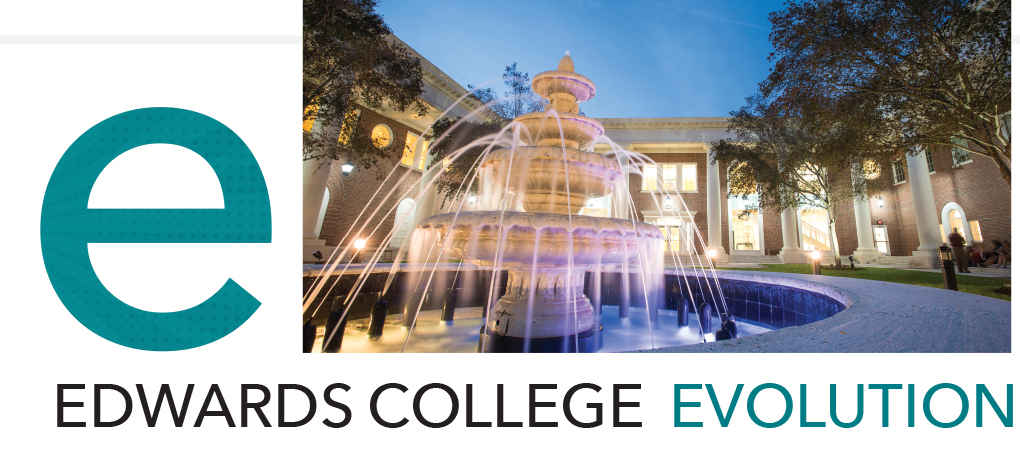
by Caroline P. Rohr ’08
CCU’s home of the humanities and fine arts celebrates 20-year anniversary
Those who are familiar with Coastal Carolina University understand that growth is pretty much a given, and the Thomas W. and Robin W. Edwards College of Humanities and Fine Arts is no exception.
Since the dedication of the Edwards Building in 2001, the college has indeed grown, not just in the number of majors, students, faculty, and square footage, but in community impact and value, academic rigor and reputation, and student diversity and engagement.
As it celebrates its 20th year, those who have spent the past 20 years (or more) as a part of the college, as well as some newer faces, are perfectly poised to look back – and forward – two decades. People such as Robin Edwards Russell ’85, whose parents’ names reflect the college’s name, and whose life has been impacted by it as a daughter, a student, a teacher, a wife, and a mother.
“As an undergrad in the ’80s, who was not a very good student, I became inspired by a faculty member who made me curious about the world and hungry for knowledge,” said Russell, who serves her alma mater as an associate professor of theatre. “Never in a million years would I have imagined that would have led to my parents becoming philanthropists at Coastal, I would become a professor at Coastal, and I would have a daughter graduate from Coastal. To me, that’s the power of Coastal Carolina University.”
Then there are others such as Pamela Martin and Dan Ennis, who, in 1999, joined the faculty of what was then the School of Humanities and Fine Arts, and whose professional careers were just starting at the time the Edwards College was being born.
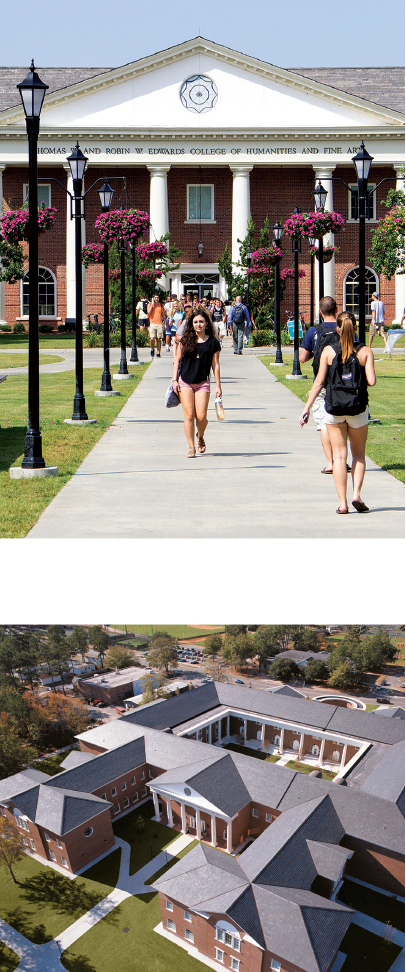
At that time, faculty and classes in the humanities and fine arts were spread throughout multiple buildings and spaces on campus. Ennis’ first office in the English department was on the second floor of Kimbel Library; Martin’s as a member of the politics department was in a portable. But they both knew something bigger was coming.
“That next year [2000], all the schools were renamed colleges, and that was a huge deal,” said Ennis, a former dean of the college, who now serves as provost and executive vice president for academic affairs. “And people talked about the new building for years; you could actually go over and visit as it was being built. At the dedication [in 2001], I remember walking through the building for the first time and into the courtyard; that was such a dramatic moment.” Martin had a similar experience at the dedication.
“It was amazing, because it was such a beautiful structure, especially the courtyard,” she said. “It was exciting to think that we had this beautiful outdoor space, and a theatre and space for an art gallery and exciting cultural events to combine with all of that.”
The opening of the Edwards Building presented the first time all the departments of the college were mostly housed underneath one roof, and the impact that had on the faculty was immediate and palpable.
“My office was in the same hallway as the theatre department, and that was wonderful,” said Martin. “As a political scientist, I always have to think in terms of rational actions, so it was wonderful to be around creative people who were using their talents in a different way than I did. That building really solidified a community.”

Thomas W. and Robin W. Edwards tour the Edwards Building construction site along with then-President Ronald Ingle.

Lynne Franken, former dean of the Edwards College, speaks during the Edwards Building dedication ceremony on Sept. 21, 2001.
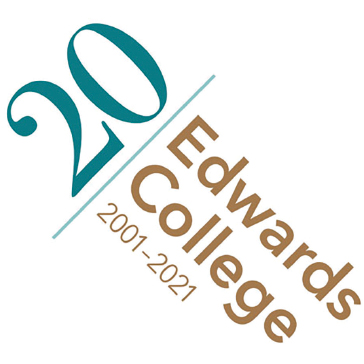
The Edwards College’s 20th-anniversary logo was designed by Jennifer Bien, a CCU visual communication design major and marketing minor, as part of an environmental design class taught by Leigh Hughes, assistant professor of graphic design.
The closeness made it easier for faculty and students of different disciplines to work together, and helped the already blossoming part of Edwards take root that has now become part of its identity: interdisciplinary collaboration.
“I collaborated a lot with the theatre department in those early years,” said Martin. “There was lots of overlay, it seems like, across the different disciplines, a lot of developing interdisciplinary approaches.”
Anyone entering the Edwards Building can see firsthand how bringing the majors together under one roof impacted the atmosphere. Turn one corner, you might hear the sounds of voice
or music students rehearsing for a production or recital while another corner takes you down a hallway filled with artwork created by students … down another hallway, you’ll likely find a student practicing guitar in the stairwell or a group of philosophy students in debate. And, no matter which hallway you walk down, there’s sure to be a bulletin board along it somewhere peppered with flyers and posters touting an upcoming event, club meeting, or student activity. On certain days, you can snag a copy of the student newspaper, The Chanticleer, or one of the two student-produced magazines, Tempo and Archarios.
Ennis credits Lynne Franken, Edwards College dean from 2001-2004, with laying the groundwork for what Edwards has become.
“She had a big influence on using the arts to center the college,” he said. “She came from a good liberal arts college and kind of established that this is what a humanities college was supposed to do. People now are building on what she started.”
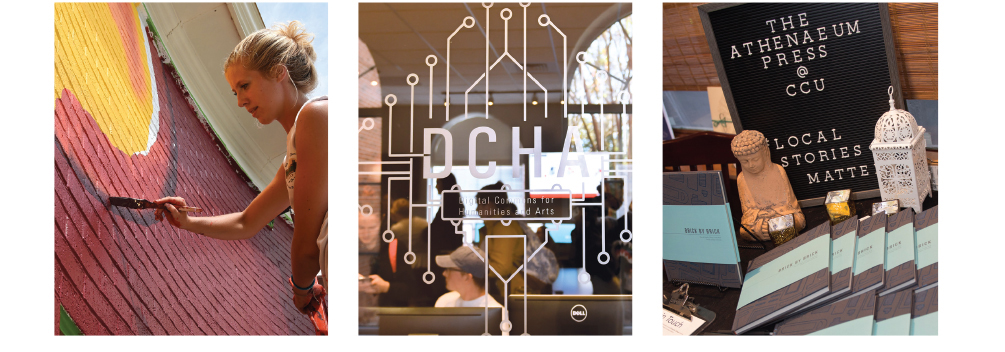
If you walk through Edwards now, it is colonized by specialized spaces. When it opened, you had classrooms and offices and performing spaces. Over the years, classrooms have been turned into teaching spaces, like the Digital Commons, The Athenaeum Press, the forthcoming intel lab.”
—Dan Ennis
CCU provost
Others who played a key role in the early days of establishing the college included Dan Selwa, John Beard, Wink Prince, Steve Nagle, and Sara Sanders. To both Ennis and Martin, the college seemed to have been built on their shoulders.
“They were sort of the architects of the college,” said Martin. “Their dedication to first-class learning and teaching environments really inspired the rest of us to try and be our best.”
“People would have these big ideas, and John Beard really ground away at the bureaucracy to make the ideas happen,” said Ennis. “Dan Selwa was an excellent chair of politics and geography, and Wink Prince was a good ambassador for the college.”
As the years passed, the college continued to grow, not just in number of students and faculty, but in the number of programs and spaces, too. The Clay D. Brittain Jr. Hall was completed in December 2012, adding room for the ever-growing communication department and becoming a home in 2014 for the Edgar Dyer Institute for Leadership and Public Policy.
As the growth continued, the spaces changed to accommodate it. “If you walk through Edwards now, it is colonized by specialized spaces,” said Ennis. “When it opened, you had classrooms and offices and performing spaces. Over the years, classrooms have been turned into teaching spaces, like the Digital Commons, The Athenaeum Press, the forthcoming intel lab ... all those additions were saying, ‘We need spaces for students to do real post-graduate work in their areas.’ If you map the progress of the college, the University is really peppered with specific, pre-professional spaces, especially if you add on Brittain Hall and Sands Hall, the band hall, Wheelwright; these are all spaces where students in every major of the Edwards College can really work on their craft.”
Many things have changed inside Edwards as these 20 years have passed, much of it due to the growth, but some of it was a natural response to trend shifts in higher education and what faculty were realizing students needed.

The Edwards College of Humanities and Fine Arts offers its students a variety of hands-on experiences to help them prepare for their future careers.
“A huge change of ethos for the college was this move from the stand-and-deliver classroom style, where the students just take classes and listen to the professor and everything else will just work out, to ‘Now we are going to work on this thing together,’” said Ennis. “It took years, but I can measure by people and square footage the gradual transition of the college from ‘the professor teaches and the students learn’ to much more hands-on, applied, externally focused, educational experiences.”
This experiential learning quality that has become foundational to Edwards is something Claudia Bornholdt, who became dean on June 1, 2019, is excited to build upon, especially since the interdisciplinary studies degree program switched homes in July from the HTC Honors College to the Edwards College.
“The idea is to grow the program significantly; there are already many new incoming students showing interest,” Bornholdt said. “A lot of Edwards’ programs are already interdisciplinary in nature, so students who want to create their degrees can pull from what we already have here by adding minors or a second major.”
It also creates the opportunity for Bornholdt and her team to analyze what programs students are creating for themselves to see if it makes sense to create a new major or minor program in response.
“That is a big part of the future for us,” she said. “We are hoping that we can form a center or institute of interdisciplinary studies that will house all of the interdisciplinary programs in the college, because this is really the future of higher education. The world is too complex to study just one major and one discipline. So in coming up with solutions for the future, it is really helpful to pull from different areas and to work collaboratively across departments and colleges.”
To Bornholdt, opportunities abound for the Edwards College during the next 20 years, not just within the walls of the building or even across campus, but across the region.
“The theatre opening in Myrtle Beach is a huge opportunity for the growth of our department,” she said. “We are working very closely with Conway, Myrtle Beach, and Georgetown, reinvigorating our communities through art. We can help revitalize certain areas and get students involved in that.”
On campus, Bornholdt hopes to make the Charles Joyner Institute for Gullah and African Diaspora Studies a nationally distinguished institute that draws students from across the country, and to develop professional certification programs for social media, cultural entrepreneurship, production, and arts management. Existing signature programs have great potential to become nationally recognized, such as the theatre, intelligence and security studies, and commercial jazz and music programs, among others.
“We have some excellent signature programs,” she said. “I want more people to recognize us for our programs. In the past 20 years, the college has continued to grow when nationally, humanities and fine arts programs are on the decline. We are in a position to continue that growth and gain national recognition. Let’s just own it!”
Lest alumni start to worry that the next time they visit campus, the beloved Edwards College will be unrecognizable, there will always be some things that stay the same.
“The University continues with its strong foundation in the liberal arts,” said Bornholdt. “This college teaches the majority of the core curriculum; every student comes through this building, and that foundation is really important. We interact with every student.”
“The Edwards College is the one place all students pass through on their way to their degree,” echoed Ennis. “Even though the college has its own majors and programs, it has never given up its identity as an entry place at the institution. Every student leaves with that Edwards stamp. There’s never a doubt that the center of gravity stays there.”
And surely, for the next 20 years at least, those who enter the Edwards Building can continue to get lost inside the halls, listening to the music, admiring the artwork, and celebrating the consistent focus on students inside.
ROBIN’S REFLECTIONS
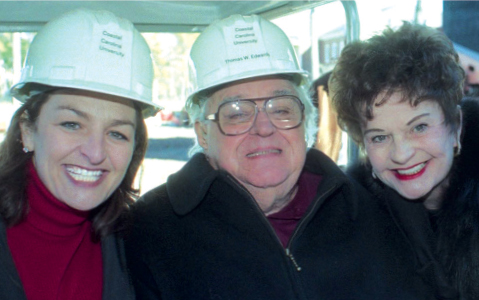
Robin Edwards Russell ’85 with her parents, Thomas W. and Robin W. Edwards.
Robin Edwards Russell ’85 is the daughter of Thomas W. and Robin W. Edwards, the namesakes of the Edwards College, and a member of the college’s theatre faculty.
“Teal is the color of our family thread. My mother is proud of that and wouldn’t want it any other way. Even though she never attended the University, she feels the sense of community. Coastal is an extension of our family.
“The saddest part of this 20th anniversary celebration is that my dad is not here to see it. He died in April 2001, just a few months before the college’s dedication ceremony that September. The other day, I was at my mom’s house and came across a copy of the building plans. It made me think about how President [Ron] Ingle would come to the house, and he and my dad would roll out those plans. Or how my dad would go to campus and put on a hard hat and walk around the construction site. He was so involved in everything about the building. He was so proud. He even picked out my office, which is the one I still use today. It’s strange, neat, and emotional all at the same time.
“When [then-theatre professor] David Millard gave his remarks during the dedication ceremony, he said: ‘Tom, you died too soon. But you would be pleased to know that it turned out well. … As this building gets formed and shaped by the teachers and students who come here, you and Robin will have fashioned something exceptional and enduring beyond any of us here tonight. We toast Robin and Tom, our friends and benefactors.’”


